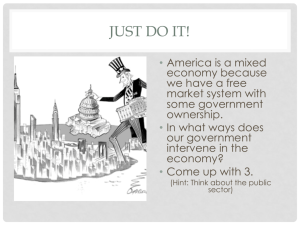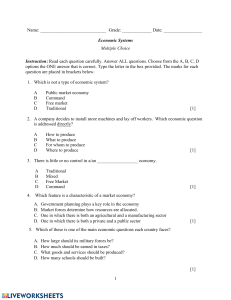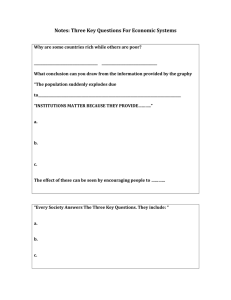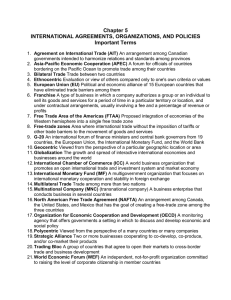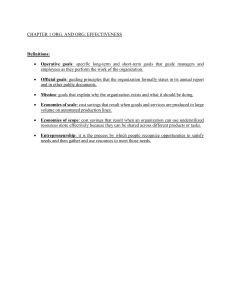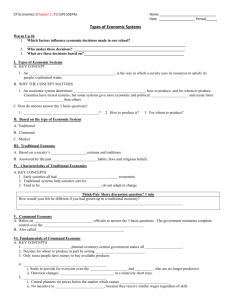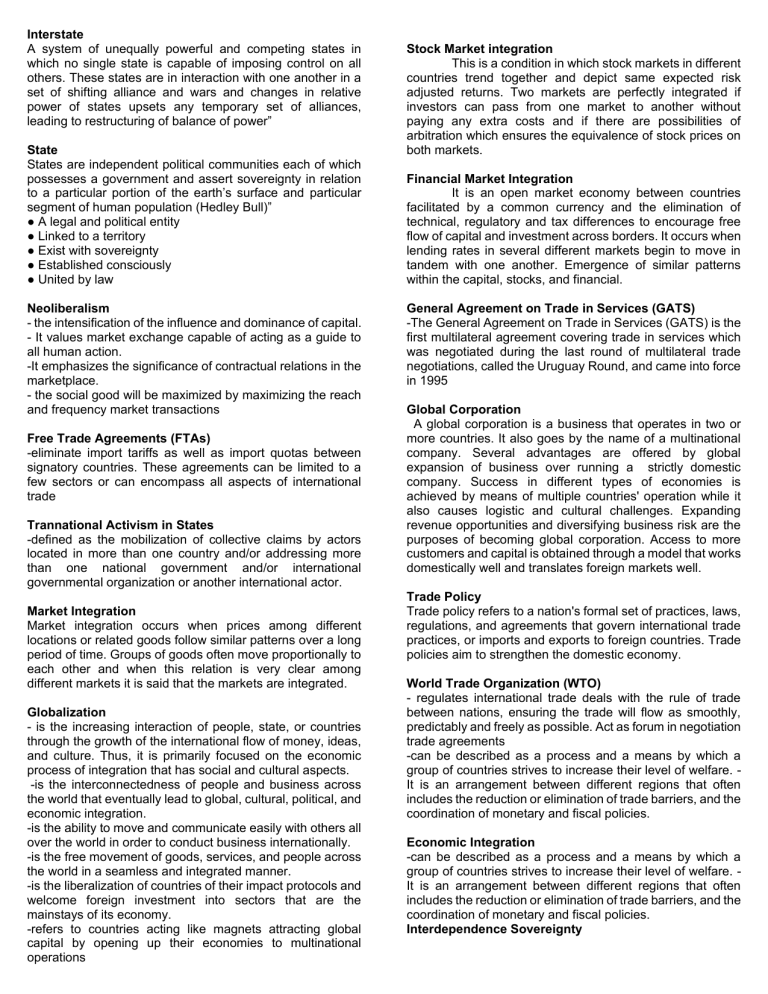
Interstate A system of unequally powerful and competing states in which no single state is capable of imposing control on all others. These states are in interaction with one another in a set of shifting alliance and wars and changes in relative power of states upsets any temporary set of alliances, leading to restructuring of balance of power” State States are independent political communities each of which possesses a government and assert sovereignty in relation to a particular portion of the earth’s surface and particular segment of human population (Hedley Bull)” ● A legal and political entity ● Linked to a territory ● Exist with sovereignty ● Established consciously ● United by law Neoliberalism - the intensification of the influence and dominance of capital. - It values market exchange capable of acting as a guide to all human action. -It emphasizes the significance of contractual relations in the marketplace. - the social good will be maximized by maximizing the reach and frequency market transactions Free Trade Agreements (FTAs) -eliminate import tariffs as well as import quotas between signatory countries. These agreements can be limited to a few sectors or can encompass all aspects of international trade Trannational Activism in States -defined as the mobilization of collective claims by actors located in more than one country and/or addressing more than one national government and/or international governmental organization or another international actor. Market Integration Market integration occurs when prices among different locations or related goods follow similar patterns over a long period of time. Groups of goods often move proportionally to each other and when this relation is very clear among different markets it is said that the markets are integrated. Globalization - is the increasing interaction of people, state, or countries through the growth of the international flow of money, ideas, and culture. Thus, it is primarily focused on the economic process of integration that has social and cultural aspects. -is the interconnectedness of people and business across the world that eventually lead to global, cultural, political, and economic integration. -is the ability to move and communicate easily with others all over the world in order to conduct business internationally. -is the free movement of goods, services, and people across the world in a seamless and integrated manner. -is the liberalization of countries of their impact protocols and welcome foreign investment into sectors that are the mainstays of its economy. -refers to countries acting like magnets attracting global capital by opening up their economies to multinational operations Stock Market integration This is a condition in which stock markets in different countries trend together and depict same expected risk adjusted returns. Two markets are perfectly integrated if investors can pass from one market to another without paying any extra costs and if there are possibilities of arbitration which ensures the equivalence of stock prices on both markets. Financial Market Integration It is an open market economy between countries facilitated by a common currency and the elimination of technical, regulatory and tax differences to encourage free flow of capital and investment across borders. It occurs when lending rates in several different markets begin to move in tandem with one another. Emergence of similar patterns within the capital, stocks, and financial. General Agreement on Trade in Services (GATS) -The General Agreement on Trade in Services (GATS) is the first multilateral agreement covering trade in services which was negotiated during the last round of multilateral trade negotiations, called the Uruguay Round, and came into force in 1995 Global Corporation A global corporation is a business that operates in two or more countries. It also goes by the name of a multinational company. Several advantages are offered by global expansion of business over running a strictly domestic company. Success in different types of economies is achieved by means of multiple countries' operation while it also causes logistic and cultural challenges. Expanding revenue opportunities and diversifying business risk are the purposes of becoming global corporation. Access to more customers and capital is obtained through a model that works domestically well and translates foreign markets well. Trade Policy Trade policy refers to a nation's formal set of practices, laws, regulations, and agreements that govern international trade practices, or imports and exports to foreign countries. Trade policies aim to strengthen the domestic economy. World Trade Organization (WTO) - regulates international trade deals with the rule of trade between nations, ensuring the trade will flow as smoothly, predictably and freely as possible. Act as forum in negotiation trade agreements -can be described as a process and a means by which a group of countries strives to increase their level of welfare. It is an arrangement between different regions that often includes the reduction or elimination of trade barriers, and the coordination of monetary and fiscal policies. Economic Integration -can be described as a process and a means by which a group of countries strives to increase their level of welfare. It is an arrangement between different regions that often includes the reduction or elimination of trade barriers, and the coordination of monetary and fiscal policies. Interdependence Sovereignty -involves a single economic market, a common trade policy, a single currency and a common monetary policy. Complete Economic Integration -the final stage of economic integration in which member states completely forego independence of both monetary and fiscal policies. Historical Foundation of the term “Globalization” ● Before the age of discovery ● Age of discovery ● 1820’s ● 1900’s ● 20th Century Economic Interdependence -The belief that globalization imposes a forced choice upon states either to conform to free market principles or run the risk of being left behind is termed into a phrase called “Golden Straitjacket” -There are two things that will happen if a country is in the Golden Straitjacket: the economy grows and politics shrinks. It is a straitjacket because it narrows the political and economic policy choices of those in power to relatively tight parameters Nation -The concept of nation emphasizes the organic ties that hold groups of people together and inspire a sense of loyalty and belonging – i.e., ethnicity, language, religion, and others (Schattle, 2014) ● A socio-cultural entity ● Linked to a group people ● May exist even w/o sovereignty ● Can be created unconsciously ● United by bond and shared history Nation-State -This refers to modern countries and their political apparatuses that rule over a single nation. Preferential Trade Areas (PTAs) -happens when there’s an agreement on reducing or eliminating tariff (tax or duty to be paid on a particular class of imports or exports) barriers on selected goods imported from other members of countries within the geographical region or area Common Market (CM) -All barriers to the mobility of people, capital and other resources within the area in question, as well as eliminating non-tariff barriers to trade, such as the regulatory treatment of product standards are removed by CM aside from containing the provisions of a customs union. Economic Union -The trading bloc that has both a common market between members, and a common trade policy towards nonmembers, although members are free to pursue independent macro-economic policies Economic and Monetary Union (EMU) Political Integration -refers to the integration of components within political systems; the integration of political systems with economic, social, and other human systems; and the political processes by which social, BRICS Economies -Brazil, Russia, India, China and South Africa (BRICS) is an acronym for the combined economies of Brazil, Russia, India, China and South Africa. BRIC, without South Africa, was originally coined in 2003 by Goldman Sachs, which speculates that by 2050 these four economies will be the most dominant. South Africa was added to the list on April 13, 2011 creating "BRICS" International Organization (IOs) -Commonly used to refer to international intergovernmental organizations on groups that are primarily made up of member-states. Asia Pacific and South Asia’s Impact on Globalization Asia was the central global force in the early modern world economy. It was the site of the most important trade routes and in some places more advanced in technology than the West such as science and medicine. India -India opened-up and emphasized an export-oriented strategy. Textiles and other low wage sectors have been a key part of the economy with highly successful software development exports. Japan - Japan embarked on procuring raw materials like coal and iron at unprecedented economies of scale allowing them to gain a competitive edge in the global manufacturing market as well as globalized shipping and procurement patterns which other countries modeled. China - China pursues a similar pattern of development at present and is now the world’s largest importer of basic raw materials such as iron and surpassed Japan, the US and Europe in steel production.
